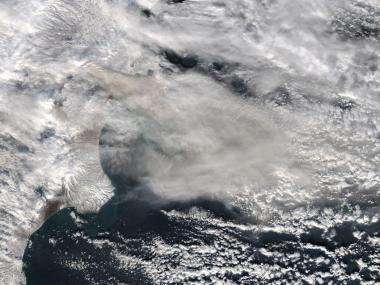NASA's Aqua satellite catches glimpse of Russia's active volcanoes

NASA's Aqua satellite flew over the erupting Shiveluch Volcano in Russia yesterday and captured a visible image of its ash plume. Shiveluch is one of Russia's most active volcano and is currently spewing ash over 6 miles high (10 kilometers) into the atmosphere. That's about 33,000 feet high and just shy of the stratosphere.
Shiveluch is also the northernmost active volcano located in Kamchatka Krai peninsula, eastern Russia. It is one of Kamchatka's largest and most active volcanoes. Shiveluch has been an active volcano since 2001.
When NASA's Aqua satellite flew over the Shiveluch volcano on Oct. 28 at 01:30 UTC or 2:30 p.m. local time Asia/Kamchatka (or Oct. 27 9:30 p.m. EDT) it captured a visible image of the volcano's light brown colored ash plume blowing in a southeasterly direction over the western North Pacific Ocean. NASA's MODIS Rapid Response Team is located at NASA's Goddard Space Flight Center in Greenbelt, Md. and provides real-time imagery of Earth from the MODIS instrument that flies aboard NASA's Aqua and Terra satellites.
Provided by JPL/NASA




















